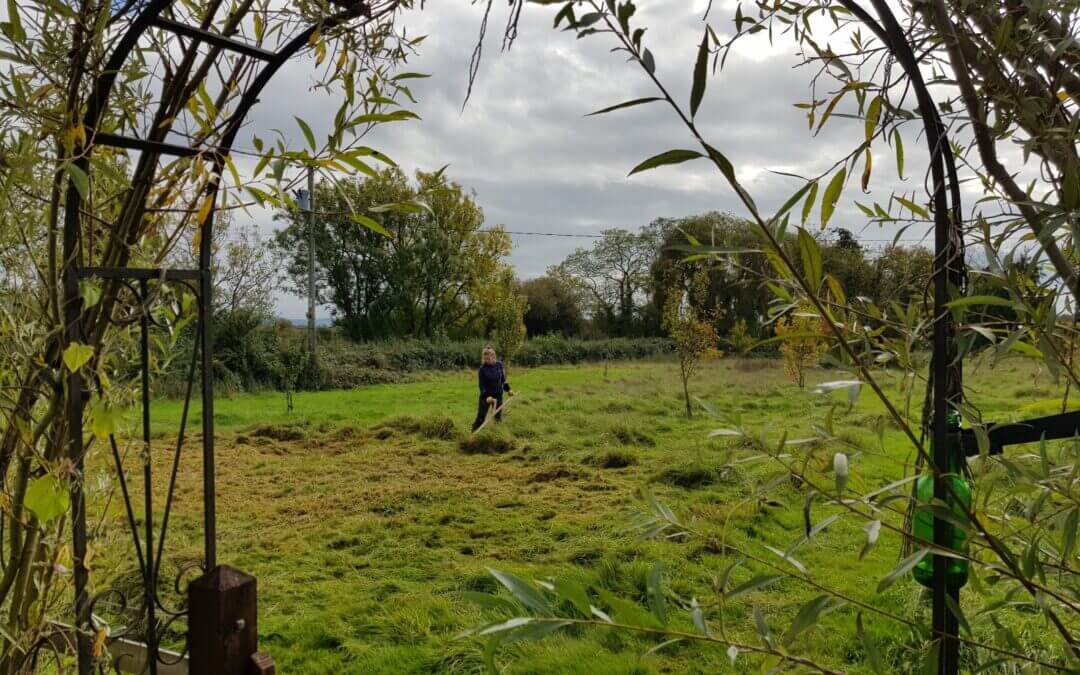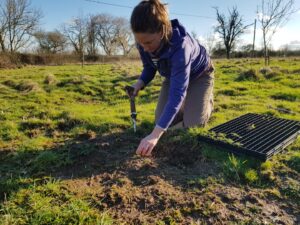Ground preparation
Planting into existing vegetation
Vegetation should be cut down to ground level and the arisings removed and the sward opened up to expose some bare ground (30-50% minimum) and reduce competition from existing vegetation. If there is an existing burden of pernicious weeds then repeated cutting to ground level over the year to weaken these weeds will help to prepare the ground for wildflowers. Exposing bare ground should be undertaken using a sturdy rake or scarifying rake or for larger areas see ground preparation advice in the next blog on wildflower seeding.
Removal of existing vegetation
If vegetation is particularly weedy, coarse or tussocky then turf could be inverted or removed in areas to create a clean planting bed or patches of vegetation killed off by laying black weed suppressant membrane to kill off vegetation over the growing season. Sites with frequent pernicious weeds such as thistles, docks and nettle should be avoided for wildflower planting where possible. However if weeds removed completely before planting (normally by the use of herbicide) and frequent weeding of any emerging seedlings is undertaken then weedy sites can be successful with the correct choice of wildflower species.
If ground is very compacted in the planting area it is recommended that soil is lightly loosened but not turned over with a broad fork or deep fork to improve soil aeration and structure to allow good root growth of wildflower species. The surface of top soil should be raked and laid flat before planting.
Planting out
Plug plants should be removed from their trays by firstly loosening the roots on the underside of the tray. Run a dibber or pencil up the rows of the tray loosening any roots that have matted together. The same should be done for any shoots and rhizomes that have joined together on the surface of the trays (this will be particularly relevant for plants that send out runners).
Plants can then be eased out of individual cells by inserting a pencil or a dibber in the hole on the underside of the tray to ease the plant up and then the plant can be gently pulled out by the base of the plant, taking care not to damage shoots.
Starting with a few smaller areas (up to 100m2) of dense planting will help plants to get established, which can then colonise larger areas of your site. This is preferable to sparsely planting larger areas as wildflowers will get lost in the existing vegetation and will be harder to manage.
Plants should be planted out in groups of 4-6 minimum to help their establishment, increase chances of pollinators finding the species and to provide more of a visual impact. Planting density will depend on many factors including; budget, species, plug size, site conditions and whether you are sowing seed as well. The following planting densities are recommended:
- Jumbo plugs (55cc) – 8-12 plugs per m2
- Micro plugs (15-30cc) 15-20 plugs per m2
These plug numbers can be halved when sowing seed at 1-2g/m2
The timing of planting will determine how well plants establish. The two best planting windows are spring and autumn as plants are in their active growth phase when there are more predictable rain patterns, the soil can be worked more easily and moisture from dew will help these plants establish naturally. If irrigation can be provided during dry spells in the initial establishment period then planting can be undertaken throughout the growing season.
The ground should be made wet before planting (after wet weather is preferable) and plug plants watered in trays before planting out. Due to their small size, plugs can be planted with a dibber or a hand trowel. When planting over large area to avoid bending down too much multiple holes can be made at the same time with a long pointed spike (e.g spikes used for making pilot holes for fence posts). No added compost, fertiliser is required for wildflower planting but if your soil is particularly dry and frequent watering is not possible then some form of natural mulch could help plants establish and prevent substrate drying out.
Rabbits and slugs will eat newly planted wildflowers so if you have a known rabbit population then protection with rabbit proof fencing is advised. If you have a wet site and a high slug population the only reliable way to deter slugs is hand picking them at night and encouraging natural predators like frogs and hedgehogs.
In substrates that are friable such as greenroof substrate or sandy, loamy soils birds can sometimes lift plugs out of the ground. It is important to anchor plugs properly; making a planting hole that is the right size for the plug itself (a snug fit) and then firming the soil in around the plugs should help avoid this.
If heavy foot traffic and disturbance by dogs is expected in public spaces then wildflower areas should be protected with natural fencing and information signs installed asking the public to help the meadow establish by keeping off the area. Mowing pathways through meadows can help manage public access to meadows going forward.
Initial Establishment
During the initial establishment period of 6-8 weeks after planting minimal aftercare is required. If there is an extended dry spell (of more than 3 days) then irrigation will be required every 2-3 days depending on the time of year.
Management is the key to sucessfully creating a wildflower meadow, please refer to our wildflower management blog page for more details.



Recent Comments